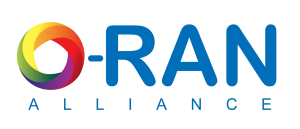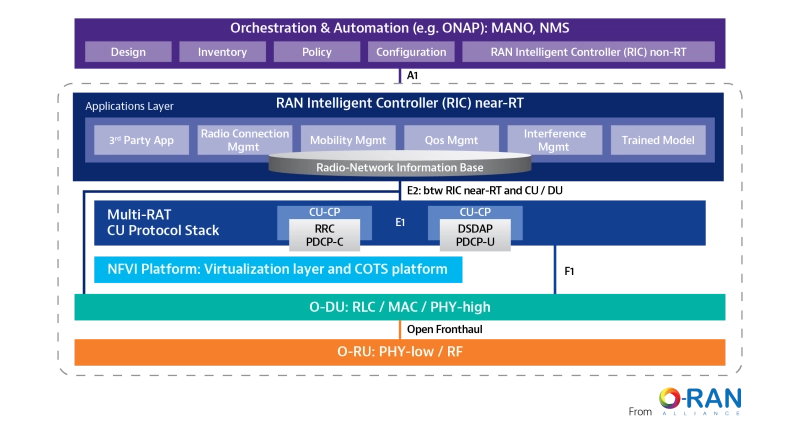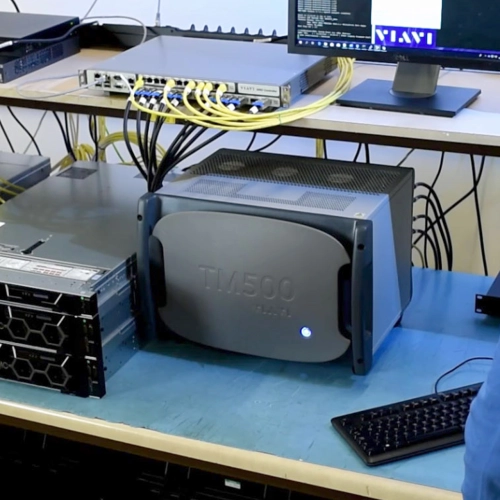Open RAN
The O-RAN ALLIANCE, O-RAN Architecture, 5G, and Testing Solutions
What is Open RAN?
An Open RAN, or Open Radio Access Network, is a concept based on interoperability and standardization of RAN elements, including a unified interconnection standard for white-box hardware and open-source software elements from different vendors. Open RAN architecture integrates a modular base station software stack on off-the-shelf hardware, which allows baseband and radio unit components from different suppliers to operate seamlessly together.
By disaggregating conventional remote radio head RRH and baseband units (BBUs) into open radio units (O-RUs), open distributed units (O-DUs), and open centralized units (O-CUs), the Open RAN architecture defined by the O-RAN Alliance and supported by 3GPP can be virtualized and containerized, while utilizing components that are both open and interoperable.
Open RAN establishes streamlined 5G RAN performance objectives through the common attributes of efficiency, intelligence, and versatility. Open RAN deployed at the network edge enables 5G applications such as autonomous transportation that require low-latency and high-reliability while supporting network slicing use cases effectively. Open RAN also enables secure and efficient over-the-air firmware upgrades.
How Can We Help?
End-to-End Portfolio
As a preeminent Open RAN test company, VIAVI has developed an End-to-end Open RAN portfolio encompassing robust test, verification, and assurance solutions from RANtoCore™ that span the entire Open RAN lifecycle.
Support and Collaboration
VIAVI has embraced the challenges of Multi-vendor Interoperability (MV-IOT) by supporting and collaborating with our partners on the development of Open RAN test tools extending from the lab to the field.
How VIAVI Enables the Open RAN Ecosystem
By adopting the O-RAN ALLIANCE fronthaul specifications, developing O-RAN compliant RAN and fronthaul test practices, participating in global O-RAN Plugfests, and establishing diverse partnerships within industry workgroups, VIAVI has forged a multi-faceted commitment to the success of Open RAN development and deployment. Championing interoperability test methodologies that minimize built-in test dependencies is essential for managing the cost of deployed network infrastructure. This includes the development of methods to evaluate Open RAN field performance.
VIAVI has embraced the end-to-end (E2E) performance testing challenges of MV-IOT by supporting and collaborating with our partners on the development of O-RAN Compliant test tools extending from the lab to the field. This includes component level wrap around testing and vendor pairing evaluations to validate performance of specific O-RU, O-DU, and O-CU combinations, and protocol compliance testing for open interfaces to verify conformance to O-RAN specifications.
As a preeminent Open RAN test company, VIAVI has developed an E2E Open RAN portfolio encompassing robust device, antenna, and core test solutions than span the entire Open RAN lifecycle. A comprehensive Open RAN test process must meet the challenge of testing each element and combination in every direction.
Validation: NITRO® Wireless brings together proven performance and interoperability test platforms used throughout the industry for 3GPP and O-RAN with cloud, intelligence, automation, and digital twin technology enabled by the Network Integrated Test, Real-Time Analytics and Optimization (NITRO) platform.
As networks become more complex and layered, a focus on measuring and assuring experience from the user perspective – by emulating usage scenarios modeled on real network data – generates the essential intelligence to simplify the delivery of new technology.
NITRO® Wireless offers products, solutions and services to enable all participants in the ecosystem – equipment manufacturers, service providers, semiconductor companies, software developers and system integrators – to accelerate technology development by validating performance at each stage in intelligent, intuitive and automated ways.
As part of the NITRO® Wireless Test Suite, the industry-leading TM500 network tester is designed to validate the user experience (UE) by emulating thousands of mobile devices across multiple cells and radio access technologies. The TM500 mitigates the challenges of multi-vendor Open RAN architecture by providing a test platform agnostic to network disaggregation. The TM500 O-RU and O-DU Testers simplify, conformance, throughput, and capacity testing processes, and real-world fronthaul data flows can be emulated, even with no O-RU present.
Scalability is a key attribute of the TM500 that allows the scope of testing to expand from functional or conformance testing to a high-capacityE2E Open RAN performance testing. Small-scale and software only TM500 solutions are available to suit focused development efforts while test appliances designed for rapid, multi-port testing meet the needs of multiple engineers and applications simultaneously.
The NITRO® Wireless TeraVM is an essential tool for 5G RAN and core network performance testing, with the Core Emulator providing a controllable and repeatable RAN test environment. The TeraVM O-CU Tester delivers a complete wraparound testing framework for the O-CU so it can be robustly tested and optimized.
For Open RAN infrastructure, the RAN Intelligent Controller (RIC) requires continuous inputs to support and optimize decision-making. The TeraVM AI RSG test utilizes an intuitive RAN scenario generator to simulate traffic flow patterns in the lab. Anomalies are used to train the RIC and assess the decision-making process. The TeraVM also supports comprehensive E2 interface testing and scalable emulation of UEs, gNBs, O-CUs, and O-DUs in any combination.
The Open RAN ecosystem is complex, with the functionality of the near-RT RIC established by a mix of microservice-based xApps that may be from a variety of suppliers. This makes it challenging for operators to establish assurance across all stages of the product lifecycle, from sandbox development through network operation. xApps from disparate sources must perform in a coherent and compatible manner when operating either independently or in tandem. Heterogeneous xApps in combination must be fully validated to implement the policies of the operator across a mix of subscribers. This can entail a wide range of services envisaged for the network across multiple network slices, and an appropriate set of mobility profiles.
The TeraVM near Real Time RIC Test provides emulated RAN inputs to a RIC under test to evaluate the efficacy of RAN changes proposed by xApps. This capability allows AI-suggested outcomes to be optimized and compared to established network KPIs.
The NITRO® Wireless Xhaul Advisor is a versatile Open RAN test solution that can run on COTS hardware to enable comprehensive interoperability testing. When deployed in conjunction with the TM500 and TeraVM, Xhaul Advisor effectively identifies and troubleshoots errors caused by timing, configuration, and packet content issues in an end-to-end test case.

Test as a Service (TaaS)
NITRO® Wireless TaaS (Test as a Service) helps deliver O-RAN projects on-time with access to leading test tools and expertise - simplify your testing process and accelerate 5G and O-RAN Time-to-Market. Delivering 5G and O-RAN projects on time and on budget is challenging but VIAVI expertise and Testing as a Service can help mitigate those risks. TaaS typically includes access to leading-edge lab-based test equipment and expert engineers that can create and execute scripts and analyze test logs. This enables you to concentrate on developing products without needing to worry about the test equipment.
Verification: The T-BERD/MTS-5800 is the industry’s smallest handheld dual-port 100G multi-purpose test instrument. It has found increasing utility in support of 5G and Open RAN. By performing Open RAN health verification testing, the MTS-5800 can identify high level fronthaul issues between the O-DU and O-RU in the field. Packet capture and filtering in this interface can enable advanced troubleshooting and analysis. The T-BERD/MTS-5800 also delivers a complete set of test parameters and profiles for Open RAN synchronization testing.
Radio performance testing to validate successful Open RAN 5G deployment includes beamforming verification, radio conformance testing, transmit power measurement and downlink (DL) modulation quality. The OneAdvisor 800 is a comprehensive, portable RAN test solution with a diverse and easily-upgradable feature set tailor made for advanced 5G and Open RAN deployment and certification tasks. Portable O-DU emulation allows field technicians to verify O-RU radio function instantly and accelerate commissioning, while radio and fiber test reports can be generated with a simple push of a button.
Visibility: The VIAVI NITRO platform provides superior network visibility across the breadth of the radio, RAN, transport, and core. Rich network performance data provides greater insight into O-RAN performance while identifying when and where intervention is needed to optimize autonomic network control systems against a backdrop of changing service and mobility requirements. New edge failure cases beyond what was tested at the pre-deployment stage can be exposed and manifest as degraded performance. This challenges the network monitoring and assurance system to provide a more complete view of the network, with richer analytics to detect problems, isolate the root cause, and provide the most appropriate mitigation.
The momentum behind Open RAN as a logical counterpart for 5G RAN disaggregation and innovation continues to build. VIAVI is accelerating next-gen Open RAN networks through active participation in cross functional forums across the telecom landscape. The annual O-RAN ALLIANCE Plugfest and Telecom Infrastructure Project (TIP) Summit are two of the prime opportunities for service providers, technology developers, system integrators, and test solution leaders pool their resources and expertise.
To align the energy and aspirations of the O-RAN ALLIANCE with TIP OpenRAN and minimize duplication of efforts, a liaison agreement between the two organizations was established. Although TIP remains agnostic regarding O-RAN specifications, the liaison agreement improves collaboration to integrate the strengths of each group. A commitment to specification development by the O-RAN ALLIANCE Technical Steering Committee has allowed the OpenRAN group to remain focused on real-world deployment strategies.
VALOR and NTIA
The VIAVI Automated Lab-as-a-Service for Open RAN (VALOR) provides fully automated, open, and impartial testing and integration for Open RAN interoperability, performance, and security. VALOR is based on the industry leading VIAVI Open RAN test suite that includes the TM500 and TeraVM solutions. The lab-as-a-service (LaaS) model empowers new Open RAN projects, designers, and engineers to benefit from advanced testing and in-house expertise without the capital investment. A recipient of the NTIA PWSCIF First Notice of Funding Opportunity, VALOR also provides free access for academic institutions and NTIA co-grantees.
Open RAN Policy Coalition
The Open RAN Policy Coalition was launched in 2020 to promote policies that support and advance the adoption of open, interoperable RAN solutions. The thirty-one initial coalition member organizations included many of the largest and most influential telecom, cloud computing, and network technology companies in the world.
The Open RAN Policy Coalition is committed to global implementation with an emphasis on the education of U.S. legislators and policy makers regarding the importance of Open RAN, especially with respect to 5G and 6G RAN architecture. Government backing of an open and interoperable RAN ecosystem fosters cross-functional industry cooperation, competition, and vendor diversity around the world.
Open RAN Energy Efficiency
3GPP has included reduced energy consumption among the top objectives for 5G networks, but exponentially higher cell density and new RAN elements like Massive MIMO make energy efficiency elusive. Open RAN has been identified as a key enabler of reduced energy consumption, with cloud native RICs utilizing AI and ML to continually balance resources, strategically turn off cells and/or frequencies, and recalibrate network slices to optimize QoS and energy consumption simultaneously. The VIAVI TeraVM AI RSG Test helps to reduce Open RAN deployment and operating costs with virtualized test capabilities, allowing developers to accurately assess the efficiency of RIC applications prior to deployment.
Open RAN and 6G
Energy efficiency, sustainability, and intelligent traffic control will also be fundamental to the success of 6G, with AI-native RAN elements built into 6G standards. Open RAN RIC use cases including deep learning (DL) models to process large volumes of data, and reinforcement learning (RL) algorithms to adjust the power of network elements, will be called upon to optimize energy-hungry applications like high-density 6G-IoT and localized learning at the edge.
The O-RAN RIC presents a golden opportunity to fully integrate AI and 6G RAN consistent with the 3GPP evolution path. The VIAVI 6G Forward Program is helping to synergize 6G and Open RAN through wireless technology research, innovation, and testing, as well as partnerships with the O-RAN Alliance, the Institute for Wireless Internet of Things, the Next G Alliance, and other industry leaders.
Stay Ahead of the Curve
Open RAN Knowledge Hub
The prospect of an Open RAN ecosystem has advanced the formation of synergistic projects, alliances, and working groups each with distinct missions and focus areas. These efforts share the common objective of enabling an Open RAN environment through standardized elements and interfaces.
OpenRAN
OpenRAN (no space) is a project group launched by the Telecom Infra Project (TIP) in 2017 with the stated objective of defining and building 2G, 3G, and 4G RAN solutions based on general purpose, vendor neutral hardware and software defined technology. This includes the creation of programable, virtualized RAN solutions based on General Purpose Processing Platforms (GPPP) and disaggregated software that accelerates the pace of innovation. The OpenRAN conglomerate has applied the expertise of their diverse member organizations toward the analysis of use cases and the development of Open RAN fronthaul algorithms.
O-RAN
Although “O-RAN” is a commonly used acronym for “Open RAN”, the hyphenated nomenclature has evolved to represent the O-RAN ALLIANCE more specifically since the group’s founding. Along with the publication of Open RAN architecture specifications, O-RAN ALLIANCE initiatives have focused on incorporating artificial intelligence (AI), specifying interfaces and APIs to drive appropriate standardization, and establishing the requisite supply chain infrastructure. These challenging endeavors provide additional ballast for the underlying O-RAN pillars of openness and intelligence.
vRAN
Virtualized RAN (vRAN) is the key enabling technology for Open RAN architecture. Decoupling hardware and software through the application of network function virtualization (NFV) principles allows the RAN to becomes more agile, flexible, and easier to upgrade. The improved efficiency and security intrinsic to vRAN also makes it an essential element of Open RAN 5G implementation with complex uses cases and access technologies necessitating more dynamic control of network resources.
The O-RAN ALLIANCE was established in 2018 by a global consortium of network operators with the stated goal of evolving radio access networks around the world. This can be accomplished through a transition to virtualized network elements, white-box hardware and open interfaces to the RAN.

Built on the complementary pillars of openness and intelligence, the O-RAN ALLIANCE has established eight discrete working groups with ambitious technical objectives including open fronthaul architecture, RAN cloudification and software specifications for the new radio (NR) protocol stack.
As a key contributor to the O-RAN ALLIANCE, VIAVI collaborates on essential multi-vendor interoperability testing (MV-IOT) to ensure confidence in disparate Open RAN fronthaul components, disaggregated software and hardware elements from multiple suppliers operating in concert.
VIAVI is actively engaged in O-RAN ALLIANCE working and focus groups contributing to interoperability test specifications, E2E test framework, Open fronthaul, xHaul Transport, Plugfest, and Test & Integration Focus Group (TIFG).
The reference O-RAN architecture introduced by the O-RAN ALLIANCE was envisioned with an eye towards next-gen RAN infrastructure with virtualized RAN on open hardware and artificial intelligence intrinsic to radio control.
Functional modules of O-RAN architecture include the RIC non-Real-Time layer to perform operations including policy management and analytics, and the RIC near Real-Time layer to perform time sensitive functions such as load balancing, handover and interference detection. Layer integration allows the RIC near Real-Time layer to benefit from intelligently trained models and real time control functions distributed by the RIC non-Real-Time layer.
The multi-RAT CU protocol stack, deployed on a virtualization platform, supports protocol processing for 4G or 5G while establishing security isolation and virtual resource allocation, among other functions. The open radio unit (O-RU) and open distributed unit (O-DU) elements are integrated through an O RAN fronthaul interface with a well defined lower level split (LLS) that supports eCPRI and RoE. Further definition and standardization of these interfaces will drive interoperability, competition and innovation into the O-RAN supply chain.
Open RAN 5G
Disaggregation is essential for 5G deployment and evolution, enabling mobile operators to open the RAN network and leverage multi-vendor solutions. Open RAN provides new avenues for RAN customization and flexibility that are commensurate with the diversity of 5G use cases and requirements.
By lowering the barrier to entry for new participants into the Open RAN 5G ecosystem, the innovation needed to meet ever evolving customer expectations can be fully unlocked. Operators will be empowered to utilize best-of-breed components based on their individual network use case profile. This opens opportunities to reduce development cycles by developing different parts of the network separately while harnessing more innovation horsepower collectively.

Operational efficiencies have been realized through past RAN innovations such as cloud RAN (cRAN), but previous advancements did not free operators from vendor lock-in. By enabling an open, multi-vendor RAN ecosystem, Open RAN introduces cloud-scale economies and competition to the RAN. Marketplace factors, combined with a more elastic and flexible RAN architecture that is already taking shape through virtualization, can enable much faster time to market (TTM) than was previously possible.
Moving away from the vendor-specific RAN paradigm not only enables more flexibility for operators, it also minimizes the “secret sauce” that leaves them reliant on a single vendor for all aspects of RAN implementation and optimization.
Competition and proliferation resulting from new entrants can potentially drive down Open RAN equipment costs. The inter-carrier, interoperability aspects of Open RAN can also be used to increase efficiencies for existing LTE networks as they continue to incorporate the virtualization and disaggregation that are prerequisite 5G RAN deployment.
Creating seamless interoperability in a multi-vendor, open ecosystem introduces new test, management and integration challenges that require diligence and cooperation to overcome. In the single-vendor model, accountability is a foregone conclusion and problem isolation and troubleshooting are managed through an established command structure.
Dispersion of vendors could potentially lead to finger pointing when root cause identification is inconclusive. These same complications could plague on-time launch schedules and revenue growth by diluting management and orchestration responsibilities across an array of new Open RAN players.
The enticing Open RAN concept of flexible interoperability also brings challenges for test and integration. To fulfill the Open RAN promise of reduced OPEX and total cost of ownership (TCO), operators must take responsibility for multi-vendor, disaggregated elements and make sure they perform together to maintain QoE standards.
With Open RAN reducing the barrier to entry for dozens of new players, interoperability is a paramount concern for both the O-RAN ALLIANCE and OpenRAN group. To address this challenge, the Open Test and Integration Center (OTIC) in Berlin, Germany has been established as a collaborative hub for commercial Open RAN development and interoperability testing. The operator led OTIC initiative benefits from the support of global telecom organizations with a shared commitment to verification, integration testing, and validation of disaggregated RAN components.
The OTIC lab provides a structured environment with common test platforms and practices that enable software developers, equipment manufacturers, and system integrators to verify functional compliance to O-RAN ALLIANCE specifications. Interoperability of disaggregated 5G access infrastructure elements can be fully validated prior to network deployment. As additional OTIC labs are planned and established around the globe, VIAVI remains committed to multi-vendor interoperability testing efforts in O-RAN ALLIANCE led initiatives.
Application Notes
Video
- 5G Solutions for Mobile Service Providers
- A Short Lesson in O-RU Direct Performance Testing (DPT)
- Citymesh and VIAVI 5G Core Test
- Direct Performance Testing of the O-RU Demo
- Open RAN End to End Automated Testing Demo
- Talking O-RAN with Sameh Yamany, CTO
- TeraVM F1 Load Generator and O-DU Simulator
- Test as a Service (TaaS)
Let Us Help
We’re here to help you get ahead.



